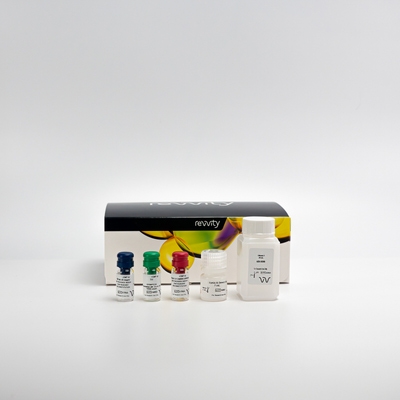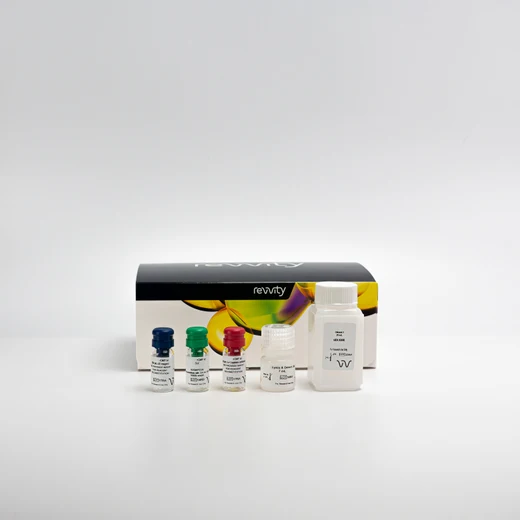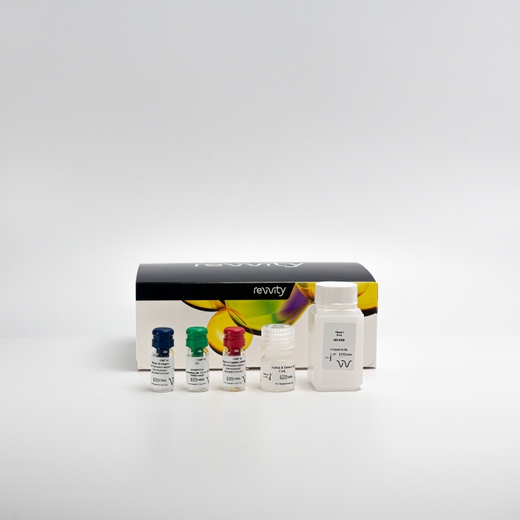

HTRF cGMP Detection Kit, 500 Assay Points


HTRF cGMP Detection Kit, 500 Assay Points






The cGMP kit is designed for the accurate quantitative measurement of Cyclic GMP, a major second messenger that mediates various cell activities.
For research use only. Not for use in diagnostic procedures. All products to be used in accordance with applicable laws and regulations including without limitation, consumption and disposal requirements under European REACH regulations (EC 1907/2006).
| Feature | Specification |
|---|---|
| Application | Protein Quantification |
| Sample Volume | 5 µL |
The cGMP kit is designed for the accurate quantitative measurement of Cyclic GMP, a major second messenger that mediates various cell activities.
For research use only. Not for use in diagnostic procedures. All products to be used in accordance with applicable laws and regulations including without limitation, consumption and disposal requirements under European REACH regulations (EC 1907/2006).



HTRF cGMP Detection Kit, 500 Assay Points



HTRF cGMP Detection Kit, 500 Assay Points



Product information
Overview
The cGMP assay kit accurately measures Cyclic GMP produced by cells. The assay can be used to screen molecules that modulate the Phosphodiesterase (PDE) activity. cGMP is a major second messenger that mediates cell activities by activating various protein effectors. Cellular cGMP is synthesized by soluble guanylyl cyclases and particulate guanylyl cyclase, triggered by nitric oxide and atrial natriuretic peptide (ANP) binding respectively. The cGMP kit offers superior benefits over traditional ELISA readouts with the ease-of-use and high sensitivity of homogeneous TR-FRET assays.
Specifications
| Application |
Protein Quantification
|
|---|---|
| Brand |
HTRF
|
| Detection Modality |
HTRF
|
| Product Group |
Kit
|
| Sample Volume |
5 µL
|
| Shipping Conditions |
Shipped Ambient
|
| Target Class |
Biomarkers
|
| Technology |
TR-FRET
|
| Therapeutic Area |
Cardiovascular
|
| Unit Size |
500 Assay Points
|
Video gallery

HTRF cGMP Detection Kit, 500 Assay Points

HTRF cGMP Detection Kit, 500 Assay Points

Citations
How it works
Assay principle
The kit is based on a competitive format involving a specific antibody labelled with Cryptate (donor) and cGMP coupled to d2 (acceptor). cGMP produced by cells competes with d2-labelled cGMP for binding to monoclonal anti-cGMP Eu Cryptate.

Assay protocol
The cGMP assay features a streamlined protocol with only two incubation steps:
- Cell stimulation by target compounds
- cGMP detection using HTRF reagents.
This protocol requires only a single, one-hour incubation period following cell stimulation.

Assay details
Specifications
Working range: |
0.5 to 500 nM |
|---|---|
| EC50: | 21 nM |
| Detection limit: | 0.7 nM |
| Specificity: | cGMP 100%, GMP <0.003%, GDP <0.001%, GTP <0.003%, AMP, ATP cAMP 0.001% |

Assay validation
Cell dependent cGMP production & ANP titration
The cGMP assay is extremely sensitive and has a wide working range (0.5 - 500 nM), giving the flexibility to use a wide range of cells per well. Figure 1 shows the results of assays performed using 300 and 20,000 cells per well and stimulated with S-nitroso-N-acetylpenicil amines (SNAP), a direct activator of soluble Guanylate Cyclase (GC) enzyme. Statistically significant quantities of cGMP were detected from as few as 300 cells. A typical dose response curve is shown in Figure 2 for cells stimulated with Atrial Natriuretic Peptide (ANP), a direct activator of particulate GC.
Figure 1: 300 to 20,000 RFL-6 rat lung fibroblasts were plated per well in a low volume 384-well microplate. Cells were incubated either in the presence or absence of SNAP and cGMP, quantified using the HTRF cGMP kit following the standard assay protocol.

Figure 2: 10,000 RFL-6 rat lung fibroblasts were plated per well in a low volume 384-well microplate and stimulated with increasing concentrations of ANP. cGMP levels were calculated using the HTRF cGMP kit, following the standard assay protocol.

Phosphodiesterase
| Gene family | Major tissue expression | Substrate |
|---|---|---|
| PDE2 | Adrenal cortex, brain, heart | cAMP/cGMP |
| PDE3 | Heart, adipose tissue, pancreas, platelets | cAMP/cGMP |
| PDE4 | Many tissues | cAMP |
| PDE5 | Lung, platelets, smooth muscle, corpus cavernosum | cGMP |
| PDE6 | Rod and cone photoreceptor outer segments | cGMP |
| PDE7 | Skeletal muscle, T-cells, B-cells | cAMP |
| PDE8 | Testis, liver, thyroid | cGMP |
| PDE9 | Kidney/td> | cAMP/cGMP |
| PDE10 | brain | cAMP/cGMP |
| PDE11 | Skeletal muscle, prostate | cAMP/cGMP |
Phosphodiesterase inhibitor testing
IBMX (3-Isobutyl-1-Methylxanthine) is a non-selective inhibitor and Rolipram is a selective inhibitor of PDE4. The PDE4 concentration is 5 ng/ml and cAMP substrate is used at a final concentration of 44 nM.


Dose-response analysis of IW-1973 over cGMP and pVASP Ser 2 39
Increases in IW-1973 increases both cGMP production and VASP phosphorylation. IW-1973 is a sGC stimulator. cGMP production and VASP phosphorylation were measured using the HTRF assays.
Adapted from Tobin J.V, et al (2018). Pharmacological characterization of IW-1973, a novel soluble guanylate cyclase stimulator with extensive tissue distribution, anti-hypertensive, anti- inflammatory, and anti-fibrotic effects in preclinical models of disease. J Pharmacol Exp Ther 365(3):664-675

Simplified pathway
Nitric Oxide signaling pathway
Nitric Oxide is a key effector protein that - among other roles - is involved in cardiovascular hemostasis and vascular relaxation. In the event of a vascular stress, NO is synthesized at its location. It binds to sGC on the environing tissues, triggering the downstream decrease of Ca2+ and increase of cGMP, which in turn alters the activity of a collection of protein kinase G, cyclic nucleotide-gated ion channels and phosphodiesterases, leading to the vasodilatation of nearby vessels, blood flow increase and lowered tension.

Resources
Are you looking for resources, click on the resource type to explore further.
Atherosclerosis pathogenesis, cellular actors, and pathways
Atherosclerosis is a common condition in which arteries harden and...
Discover the versatility and precision of Homogeneous Time-Resolved Fluorescence (HTRF) technology. Our HTRF portfolio offers a...
This guide provides you an overview of HTRF applications in several therapeutic areas.
SDS, COAs, Manuals and more
Are you looking for technical documents related to the product? We have categorized them in dedicated sections below. Explore now.
-
LanguageEnglishCountryUnited States
-
LanguageFrenchCountryFrance
-
LanguageGermanCountryGermany
-
LanguageGreekCountryGreece
-
LanguageItalianCountryItaly
-
LanguageSpanishCountrySpain
-
LanguageEnglishCountryUnited Kingdom
-
Lot number18ALot dateJune 16, 2025
-
Lot number18BLot dateJune 16, 2025
-
Lot number19ALot dateJune 16, 2025
-
Lot number17HLot dateApril 13, 2025
-
Lot number17FLot dateApril 13, 2025
-
Lot number17GLot dateApril 13, 2025
-
Lot number17ELot dateApril 13, 2025
-
Lot number17DLot dateApril 13, 2025
-
Resource typeManualLanguageEnglishCountry-


How can we help you?
We are here to answer your questions.






























